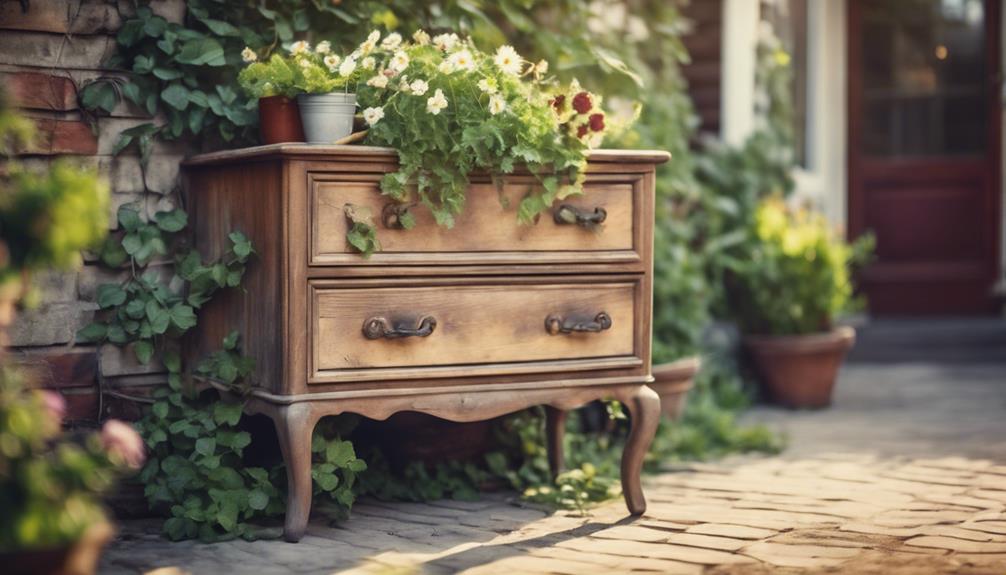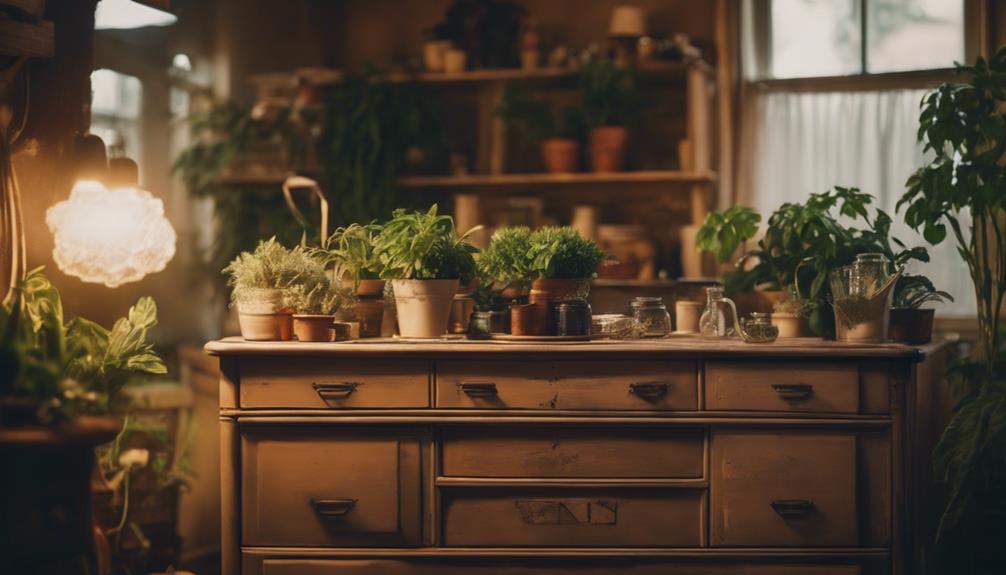You've got an old dresser that's seen better days, but instead of sending it to the landfill, you can breathe new life into it with a little creativity and some TLC. You can repurpose the drawers as a bookcase, jewelry holder, or nightstand, or add a fresh coat of paint for a new look. Alternatively, you can upcycle the entire dresser into stylish furniture like a bench, shelves, or storage units. With some imagination, you can transform it into a kitchen island, pet station, or home office desk. There's a world of possibilities waiting to be explored…
Key Takeaways
• Transform an old dresser into a functional piece, like a bookcase, jewelry holder, or nightstand, with a fresh coat of paint.
• Repurpose dresser drawers as unique storage solutions, such as a Kids Storage Bench, wall unit, or under-bed storage.
• Upcycle an old dresser into stylish and functional furniture, like a bench, shelf, or storage unit, to provide creative storage solutions.
• Give an old dresser a makeover with paint and refinishing options, like chalk paint, distressed finishes, or high-gloss paint, to update its look.
• Repurpose an old dresser for outdoor use, transforming it into a planter stand, potting bench, or functional outdoor furniture to enhance outdoor living areas.
Transforming Dresser Drawers
Transforming your old dresser drawers into functional pieces can breathe new life into discarded furniture and add a touch of creativity to your home decor. By repurposing these old furniture pieces, you can create unique and functional items that not only reduce waste but also showcase your creativity.
One of the most popular repurposed dresser ideas is to turn them into a bookcase. Simply separate and attach the front pieces vertically to create shelves, and you'll have a one-of-a-kind storage unit.
Alternatively, you can hang a drawer on the wall and add hooks to create a jewelry holder or mount the fronts on brackets to create a wall unit for kids' books. You can even transform a dresser drawer into a nightstand by splitting it, disassembling the drawers, and giving it a fresh coat of paint.
With a little creativity, you can breathe new life into old furniture and create functional pieces that reflect your personal style.
Creative Storage Solutions

By thinking outside the box, you can repurpose old dresser drawers to create unique storage solutions that cater to your specific needs, from jewelry and book storage to clever hiding spots for kids' items.
With a little creativity, you can breathe new life into old furniture. Use those drawers to create a Kids Storage Bench, where toys and supplies are kept organized and within reach.
Consider repurposing the drawers as wall units, ottomans, or under-bed storage for practical organization. You can even turn them into functional pieces like command zones, dog beds, or dollhouses for creative storage options.
Get inspired by exploring DIY projects that transform dresser drawers into garden displays, cat condos, or headboards. By repurposing old dressers, you can find versatile storage solutions for unconventional spaces like the garage, shed, or outdoors.
With a little imagination, you can give old furniture a new purpose, making the most of your old dresser's potential.
Upcycled Furniture Projects

You can repurpose an old dresser into a stylish and functional piece of furniture, such as a bench, shelf, or storage unit, that adds a personal touch to your home decor.
Through upcycled furniture projects, you can transform an old dresser into a unique piece that not only reduces waste but also provides creative storage solutions for various spaces in your home.
Whether you're looking to create a one-of-a-kind bench or a functional storage unit, upcycling old furniture can be a fun and rewarding DIY project.
By repurposing an old dresser, you can give new life to a piece of furniture that would otherwise end up in a landfill.
Upcycled dresser projects can range from simple DIY makeovers to more complex furniture conversions, allowing you to get creative and experiment with different styles and designs.
With a little imagination and some basic DIY skills, you can turn an old dresser into a functional piece of furniture that reflects your personal style and adds character to your home.
Dresser Makeover Ideas

As you consider giving your old dresser a makeover, you're likely wondering where to start.
Two essential steps in the process are exploring paint and refinish options, which can completely transform the look and feel of your dresser, and updating hardware accents to add a touch of modernity.
Paint and Refinish Options
With a fresh coat of paint or a new finish, an old dresser can be transformed into a one-of-a-kind piece that reflects your personal style.
You can give your old furniture a Repurposed Life by exploring various paint and refinish options. Consider painting your dresser with chalk paint for a trendy, matte finish that requires minimal prep work.
Alternatively, refinish it with a distressed look by sanding edges and corners after painting for a rustic, weathered appearance. If you want a modern look, use a high-gloss paint to give your dresser a sleek finish that reflects light and adds a pop of color to a room.
For a classic, elegant look, stain your dresser to highlight the natural wood grain, which complements traditional decor. You can also experiment with different painting techniques like ombre, stenciling, or color blocking to transform your old dresser into a unique and stylish piece of furniture.
Update Hardware Accents
Swap out outdated hardware accents on your old dresser for a quick, budget-friendly facelift that can completely revamp its look and feel. By updating the hardware accents, you can give your dresser a fresh, modern look that complements your existing decor. This simple DIY project requires minimal effort and investment, making it an ideal solution for those on a budget.
When selecting new hardware accents, take into account the overall style and color scheme of your dresser. Choose hardware that complements these elements to create a cohesive and polished look.
Here are some popular hardware accent options to explore:
| Hardware Accent Style | Description |
|---|---|
| Modern Knobs | Sleek, minimalist designs in a variety of finishes |
| Vintage-Style Handles | Ornate, decorative designs with an antique flair |
| Industrial-Chic Pulls | Edgy, industrial-inspired designs with an urban vibe |
| Crystal Knobs | Luxurious, crystal-encrusted knobs for a touch of elegance |
Repurposing for Outdoor Use

Transform your old dresser into a charming outdoor focal point by repurposing it as a unique planter stand, potting bench, or quirky outdoor bar. You can breathe new life into your old furniture by incorporating it into your garden decor.
Consider removing the drawers and adding shelves to create a functional potting bench, perfect for storing gardening supplies and tools. Alternatively, you can paint the dresser with outdoor-friendly paint and use it as a storage solution for outdoor items.
You can even repurpose the dresser as a decorative piece on your porch or patio, adding a touch of charm and functionality to your outdoor space. By repurposing your old dresser for outdoor use, you'll not only reduce waste but also add character and functionality to your garden or outdoor living area.
DIY Home Decor Inspiration

You can discover a world of creative possibilities by repurposing old dresser drawers into unique, functional pieces that add character to your home decor. With a little imagination, you can transform an old chest of drawers into a one-of-a-kind conversation starter.
Visit your local thrift store to find the perfect piece to repurpose, or breathe new life into a family heirloom.
Here are a few diy home decor inspiration ideas to get you started:
- Repurpose dresser drawers into a functional bookcase by separating and attaching front pieces vertically for shelves.
- Transform a dresser drawer into a unique jewelry holder by hanging it on the wall and adding hooks.
- Create a stylish and practical storage ladder by repurposing old drawers and attaching them securely to a small stepladder.
Giving Old Dressers New Life

By repurposing an old dresser, you can breathe new life into a discarded piece of furniture and create a one-of-a-kind addition to your home decor. Transforming furniture through upcycling can give your old dresser a new purpose, and you can get creative with the possibilities.
You can turn it into a functional piece like a bench, shelf, or storage unit, or get more innovative and create a dollhouse, pet feeding station, or even a hidden laptop workspace. The beauty of repurposing an old dresser lies in its cost-effectiveness and the opportunity to personalize your furniture while promoting sustainability.
By taking on this DIY project, you'll not only reduce waste but also add a unique touch to your home. With a little creativity, you can turn an old dresser into a conversation starter and a demonstration of your resourcefulness.
Frequently Asked Questions
How Can I Repurpose an Old Dresser?
You're wondering how to repurpose an old dresser, and the possibilities are endless!
You can transform it into a stylish storage bench, a functional shelf for displaying decorative items, or even a unique piece of furniture like a dollhouse or pet feeding station.
Get creative with the drawers too – turn them into ottomans, jewelry holders, or wall units for extra storage.
With a little DIY magic, that old dresser can become a stunning addition to your home.
How Do You Redo an Old Wooden Dresser?
You're ready to breathe new life into that old wooden dresser. To redo it, start by sanding away the old finish and imperfections.
Next, apply a primer to prepare the surface for painting or staining.
Then, use high-quality paint or stain to give it a fresh look. Consider adding new hardware or decorative elements for a modern touch.
Can You Turn a Dresser Into a Bookshelf?
You're wondering if you can turn a dresser into a bookshelf. The answer is yes, you can!
By removing the drawers, sanding and painting the dresser, and securing the drawers in place, you can create a unique and functional bookshelf.
This repurposed piece won't only add character to your room but also provide ample storage for your books.
Can You Paint Over an Old Dresser?
As you stand before that outdated dresser, wondering what to do with it, remember that a fresh coat of paint can work wonders!
You can, in fact, paint over an old dresser to give it a brand-new look. By sanding and priming the surface, you'll guarantee a smooth finish.
Choose a high-quality paint, and consider trendy chalk paint or quick-drying spray paint for a professional-looking result.
Conclusion
As you've seen, an old dresser is like a time capsule, waiting to be rediscovered and revamped.
From transforming drawers into clever storage solutions to upcycling them into outdoor planters, the possibilities are endless.
So, don't be a Philistine and toss that vintage dresser; instead, give it a fresh coat of paint and a new lease on life.
Who knows, it might just become the crown jewel of your DIY home decor.










